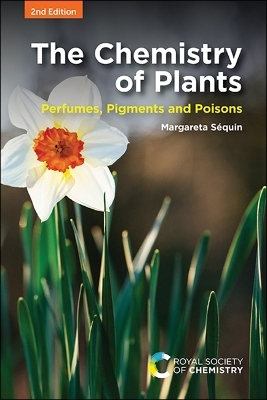
Chemistry of Plants
Perfumes, Pigments and Poisons
Seiten
2021
|
2nd edition
Royal Society of Chemistry (Verlag)
978-1-78801-901-9 (ISBN)
Royal Society of Chemistry (Verlag)
978-1-78801-901-9 (ISBN)
This new edition of a popular book, eases access to organic chemistry by connecting it with the world of plants and their colours, fragrances and defensive mechanisms.
Why are some plants so important to humans? The chemistry of the plants has a lot to do with it!
The plant world offers a fascinating way to explore basic chemistry concepts. The spectacular variety of colors, fragrances and other characteristics of plants are driven by the seemingly subtle differences in the structure and properties of organic compounds. Well-known flowers, like daffodils and narcissus, are examples of plants that provide ample perfumes, pigments and poisons as part of their intricate and fascinating chemistry.
This second edition retains it accessibility, expanding on the first edition and combining scientific concepts with colorful pictures and stories in simple, clear language. Readers will find introductory information on some chemistry and plant biology. This prepares them for the more complex chemical structures that compose plant substances, many of them of vital importance to humans. The final chapter has been expanded, in particular the sections on medicinal plants and on genetic modification. The end-of chapter references have been thoroughly updated with articles, books, and relevant websites that illustrate the topics discussed.
Dr Margareta Sequin, an organic chemist and plant enthusiast, has taught popular undergraduate college level courses on plant chemistry to non-chemistry majors and has led numerous field seminars for the general public. The comments and questions from these audiences and the topics that especially captured people’s interest have greatly shaped this book.
The Chemistry of Plants addresses an audience with little previous chemistry knowledge, but will appeal to the expert reader looking for an understanding of more complex plant compounds. It can be used both as a text to introduce organic chemistry as it relates to plants and as a text of reference for more advanced readers.
Why are some plants so important to humans? The chemistry of the plants has a lot to do with it!
The plant world offers a fascinating way to explore basic chemistry concepts. The spectacular variety of colors, fragrances and other characteristics of plants are driven by the seemingly subtle differences in the structure and properties of organic compounds. Well-known flowers, like daffodils and narcissus, are examples of plants that provide ample perfumes, pigments and poisons as part of their intricate and fascinating chemistry.
This second edition retains it accessibility, expanding on the first edition and combining scientific concepts with colorful pictures and stories in simple, clear language. Readers will find introductory information on some chemistry and plant biology. This prepares them for the more complex chemical structures that compose plant substances, many of them of vital importance to humans. The final chapter has been expanded, in particular the sections on medicinal plants and on genetic modification. The end-of chapter references have been thoroughly updated with articles, books, and relevant websites that illustrate the topics discussed.
Dr Margareta Sequin, an organic chemist and plant enthusiast, has taught popular undergraduate college level courses on plant chemistry to non-chemistry majors and has led numerous field seminars for the general public. The comments and questions from these audiences and the topics that especially captured people’s interest have greatly shaped this book.
The Chemistry of Plants addresses an audience with little previous chemistry knowledge, but will appeal to the expert reader looking for an understanding of more complex plant compounds. It can be used both as a text to introduce organic chemistry as it relates to plants and as a text of reference for more advanced readers.
Basic Plant Chemistry Concepts;
The Molecular Building Blocks;
Perfumes, Volatile Plant Scents;
Colorful Plant Pigments;
Poisons and Other Plant Defenses;
Plants and People
| Erscheinungsdatum | 08.02.2021 |
|---|---|
| Verlagsort | Cambridge |
| Sprache | englisch |
| Maße | 152 x 228 mm |
| Gewicht | 345 g |
| Themenwelt | Sachbuch/Ratgeber ► Natur / Technik |
| Naturwissenschaften ► Biologie ► Botanik | |
| Naturwissenschaften ► Chemie ► Organische Chemie | |
| ISBN-10 | 1-78801-901-6 / 1788019016 |
| ISBN-13 | 978-1-78801-901-9 / 9781788019019 |
| Zustand | Neuware |
| Informationen gemäß Produktsicherheitsverordnung (GPSR) | |
| Haben Sie eine Frage zum Produkt? |
Mehr entdecken
aus dem Bereich
aus dem Bereich
Gefäßpflanzen: Grundband
Buch | Hardcover (2021)
Springer Spektrum (Verlag)
CHF 62,95
Diversität, Morphologie, Ökologie und Evolution der Pilze
Buch | Softcover (2023)
Springer (Verlag)
CHF 69,95
ein Baum erzählt seine erstaunliche Geschichte
Buch | Hardcover (2024)
Ludwig (Verlag)
CHF 32,15


